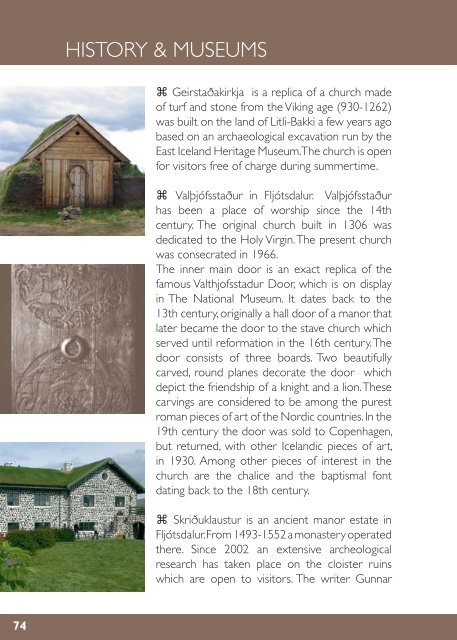The Official Tourist Guide - East Iceland
The Official Tourist Guide - East Iceland
The Official Tourist Guide - East Iceland
Create successful ePaper yourself
Turn your PDF publications into a flip-book with our unique Google optimized e-Paper software.
74<br />
HISTORY & MUSEUMS<br />
⌘ Geirstaðakirkja is a replica of a church made<br />
of turf and stone from the Viking age (930-1262)<br />
was built on the land of Litli-Bakki a few years ago<br />
based on an archaeological excavation run by the<br />
<strong>East</strong> <strong>Iceland</strong> Heritage Museum. <strong>The</strong> church is open<br />
for visitors free of charge during summertime.<br />
⌘ Valþjófsstaður in Fljótsdalur. Valþjófsstaður<br />
has been a place of worship since the 14th<br />
century. <strong>The</strong> original church built in 1306 was<br />
dedicated to the Holy Virgin. <strong>The</strong> present church<br />
was consecrated in 1966.<br />
<strong>The</strong> inner main door is an exact replica of the<br />
famous Valthjofsstadur Door, which is on display<br />
in <strong>The</strong> National Museum. It dates back to the<br />
13th century, originally a hall door of a manor that<br />
later became the door to the stave church which<br />
served until reformation in the 16th century. <strong>The</strong><br />
door consists of three boards. Two beautifully<br />
carved, round planes decorate the door which<br />
depict the friendship of a knight and a lion. <strong>The</strong>se<br />
carvings are considered to be among the purest<br />
roman pieces of art of the Nordic countries. In the<br />
19th century the door was sold to Copenhagen,<br />
but returned, with other <strong>Iceland</strong>ic pieces of art,<br />
in 1930. Among other pieces of interest in the<br />
church are the chalice and the baptismal font<br />
dating back to the 18th century.<br />
⌘ Skriðuklaustur is an ancient manor estate in<br />
Fljótsdalur. From 1493-1552 a monastery operated<br />
there. Since 2002 an extensive archeological<br />
research has taken place on the cloister ruins<br />
which are open to visitors. <strong>The</strong> writer Gunnar


